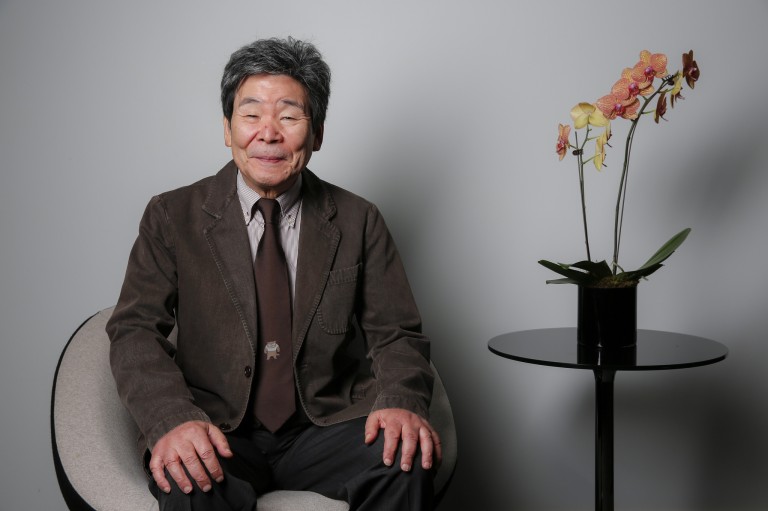Happy New Years everyone. Welcome to the first post of 2016!! Though I know I will find myself still writing 2015 for the next couple weeks. Now onto the review!
A few months ago when I started this blog, one of my first entries was about the Studio Ghibli documentary, “Yume to Kyoki no Ohkoku (The Kingdom of Dreams and Madness).” The film is currently streaming on Netflix. In order to find it, you will have to look it up by its Japanese name or search under keywords like “Miyazaki” or “Studio Ghibli.” I promised then to write a review on it then, but never got around to writing it. Well, better late than never, I say. Here is my review for “The Kingdom of Dreams and Madness.” *Warning possible spoilers for those who have not seen The Wind Rises.*

“The Kingdom of Dreams and Madness” takes place during the year the studio is furiously working on “The Wind Rises,” and “Princess Kaguya.” The film is directed and narrated by Mami Sunada. At just about 2 hours, we get many perspectives of the day to day routines during production at this prolific studio from pre-production to the announcement of Miyazaki’s retirement.
As the documentary delves into the history of the studio, we are introduced to the three heads that created the company as we know it today.

First, we have the man we all know; Hayao Miyazaki. The artist. The dreamer. The eccentric. Miyazaki takes care and control of all production and art on his films. He storyboards all the films himself as well, usually not finishing or knowing the ending to said films until they are well into the middle of production.

Next, we have Toshio Suzaki. Or as he usually is referred to, “Suzuki-San,” and “Producer.” He is the Producer of all of Miyazaki’s films. He is in charge of all meetings, press conferences, and any joint decisions made in regards to Miyazaki’s films. He has worked and known Miyazaki for 35 years.

Last but not least of the big three is Isao Takahata. Isao met Hayao while they were working at Toei Animation. He and Miyazaki founded Studio Ghibli in 1985 together. Isao has directed numerous films for Ghibli, his most famous being Grave of the Fireflies. At the time of this documentary, he is working on “Princess Kaguya.” Throughout the documentary, there are fears that he would not finish the film, which was to open along side “The Wind Rises.” In most recent years, Takahata and Miyazaki butt heads on different aspects of the studio, so they work on their respective films in different buildings.
Mami Sunada paints the documentary with a range of emotions as the days progress to the release of both films. We get lighthearted and soothing feelings in some scenes while others paint a dim, almost grim picture of what might be ahead for the Studio along with Miyazaki’s feelings about it all. There are many funny moments as well that you kind of chuckle to yourself after watching them.
First scene that I found very cute and funny is in the beginning of the documentary, as the whole staff gets up after a few hours of work and starts mid-day exercises. Miyazaki does them as well, but lags behind ever so slightly. He complains that he never memorized the routine.

Another such scene I found very amusing is when Miyazaki-San and Suzuki-San are discussing possible voice actor for the main role of Jiro Horikoshi. Miyazaki has gone through the list and is disappointed with the choices. he says none of them grasp the emotions he is trying to portray. After going back and forth, he jokingly considers a fellow anime director; Hideki Anno (Neon Genesis Evangelion) to be a perfect choice. After the jokes are put aside, the more Miyazaki thinks about it, the more he considers Hideki might be perfect for the part. They call him up to have him audition for the part. Hideki does it and Miyazaki gives him the role.

Despite many uplifting moments and every fans excitement at peeking into this very famous studio, the documentary also shows frustration, and the cloud that seems to loom over everyones head about where the Studio goes after Miyazaki retires. Miyazaki himself evens mentions the fact that the Studio will one day collapse after he is gone. His son, Goro, doesn’t seem to want to take over, and makes an offhanded comment that he just came in just to be there. In a depressing yet happy moment when the Studio is screening the finished version of “The Wind Rises,” Miyazaki stands up and addresses his fellow animators by saying that this film out of all of his other films it the first one he cried during.
The last few minutes of the film is sad as we all know it is the morning of press conference where Miyazaki announces his retirement. While he had announced retirement before, you get the sense of finality of it all. That this is it. No more films from Miyazaki. The clip below I found very touching, especially having got to animation school, his view on what you can do in animation is spot on.
The Kingdom of Dreams and Madness is a must see not only for anime and Studio Ghibli fans; but also for film and animation enthusiasts as well. It does well into giving up that sneak peak into the studio and being genuine about it. It is worth your time. 5/5 stars.

One thought on “Review: “Yume to Kyoki no Ohkoku.””